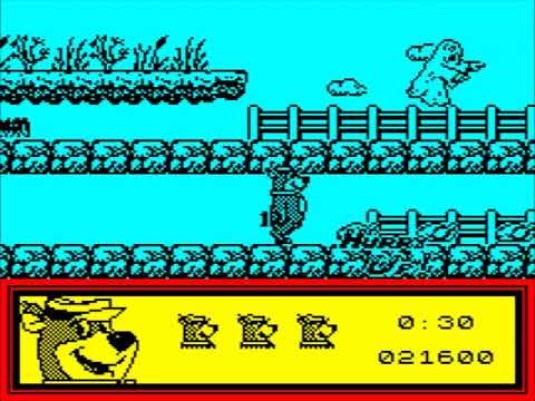
Yogi's Great Escape was one of a clutch of Hanna-Barbera licenses released by short-lived budget purveyors, Hi-Tec Software, between 1989 and 1992. In all, 13 such games featuring the likes of Top Cat, The Jetsons, and Hong Kong Phooey were made, and appeared on virtually every home computer format then available. Including the Atari 8-bit line of computers. And befitting the low price point, each game was practically identical apart from the odd graphical or sonic flourish. If you've had a stab at the Amstrad version of one of their games, you'll be able apply the exact same skills to the much snazzier Amiga iteration, for example.
But here we are on the Spectrum, a version that probably spent a little too much time in my +2 of old in the far pre-Covid times. Yogi's Great Escape wasn't exactly a game you talked about in the school yard, especially if one wanted to affect the countenance of a serious gamer. 30 years and after multiple doses of not giving a shit about many things later, I can understand why it was constantly in the datacorder - it was as no frills a platformer you could find on any system. There were no attacks as per Sonic and Mario, nor any puzzles to navigate, nor items to collect and use as in the then unstoppable Dizzy series. It was move right, avoid the traps, time the jumps, and don't get touched by the baddies. A veritable Krypton Factor assault course of a game, but with added pic-a-nic baskets and smarter-than-the-average-bear attitude.
The plot, as if it matters for a platform game, involves Ranger Smith having to privatise Jellystone Park. Presumably for a housing estate or a (then popular) golf course. This means Yogi and Boo-Boo are destined for the zoo, unless they can make a break for freedom. What follows is platforming action across the park, a forest, the wild west, a haunted swamp, and a fairground. The final level, New York City, switches the action up. Instead of platforming one has to navigate a hot air balloon across the roof tops to reach the Empire State Building. It all sounds quite pleasant, no? And if you look at the YouTube playthrough times, they usually range from 15 to 20 minutes. So quite a short piece as well. Heh. What the set up doesn't tell you is how Yogi's Great Escape is brutally difficult.
The first level is enough to try the patience of anyone, but the timings and patterns can be got down soon enough and it becomes something of a simple pleasure. But level two onwards? It's right up there with difficult games who don't owe their reputation to crappy coding. Like a lot of old home micro games, memorisation is key. There's no telling if an enemy will suddenly bear down on you giving no time to jump or react. But once experienced and added to the memory banks, one has to then learn how to get around them with perfectly timed jumps. If that wasn't bad enough, half-way through this stage they start shooting at you. Not cool, but at least true to form for the American tradition of blasting up the wildlife. Matters aren't helped later with platforms that loop back, allowing Yogi's hit detection box to brush against the feet of baddies on the floors above. A bit unfair when Yogi can't duck or anything. And then the final ballooning stage, which deserves originality points of sorts, finds birds inconveniently spawning in one's path. Slow and methodical progress is the only way to get through. Somehow achieve all this and we find the President decides to keep Jellystone open, so everyone can return home and spend more time harassing Ranger Smith. The idea a simple sit down with a politician is enough to undo their neoliberal parks sell-off strategy. Bless.
Yogi's was no technical masterpiece on any system, though the Amiga version does deserve praise for its parallax scrolling - something absent from the Atari ST version. But the Spectrum is where we're at, and the blue monochrome peppered with feeble 48k soundlets hardly push the system. But it never needed to. The controls are precise, the main sprite is recognisably Yogi, and it plays a mean game. Probably too mean a game, considering the demographic likely to have picked it up. I think much younger me barely made the third stage, thinking back.
Worth revisiting without the sepia tinge of nostalgia? Yogi's is definitely an obscure title and one seldom discussed these days, but it was probably the best of th Hi-Tec licenses and does give a flavour of what gaming on a budget looked like before the games consoles forced out the home computers.
No comments:
Post a Comment